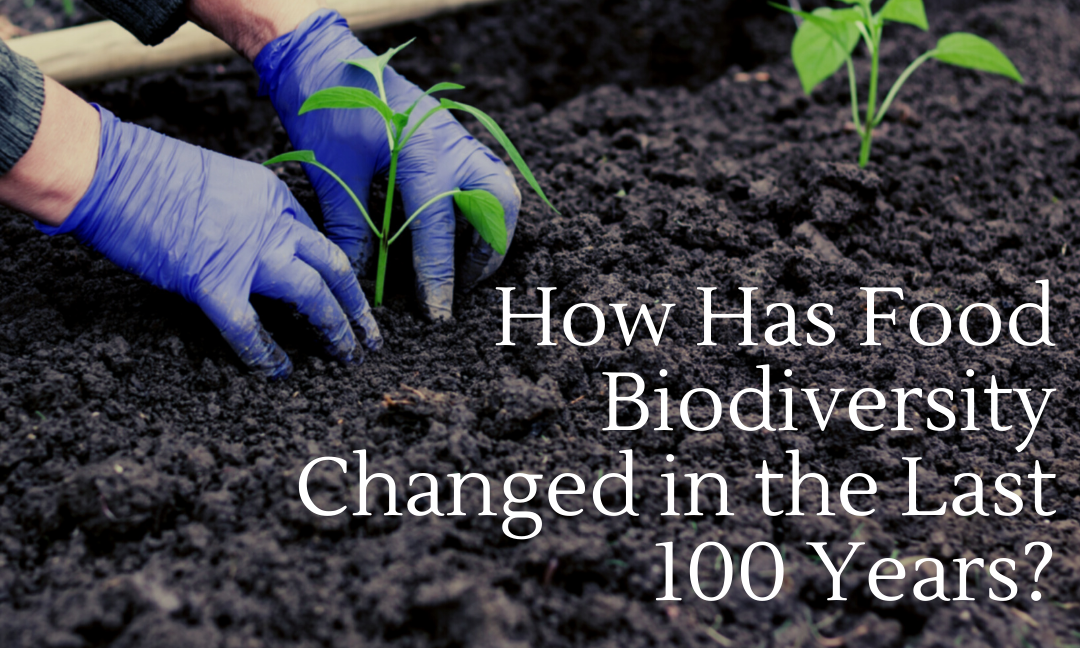Author: Margarita Cherkashyna
Editor: Melanie Ruiz
Featured Image Designer: Rayna Almas
Publisher: Rayna Almas
Agricultural biodiversity is a term used to describe all the components of biological diversity in relation to food, caused by interactions between genetic resources. Why is it important to have diversity? The diversity of plants and animals allow living things to be more adaptable to unpredictable changes such as diseases, climate change, pests, etc. this allows us to be secure in our food storage in the future. This blog post will be focusing on agricultural food biodiversity in the last 100 years and what changes it brings.
Many biologists say that we are going through the sixth mass extinction in history due to one species, humans. Biodiversity loss is a result of complex interactions between nature and humans, and to understand this pattern requires a historical perspective. We need to be focusing more on long-term processes such as technological transitions and natural changes because they bring more impact compared to short-term events such as cyclical movements of the economy and political changes.
The main obstacles to agricultural biodiversity are climate change, invasive species, overexploitation, seed loss and pollution. Human activities in technological progress are causing major changes in nature which lead to pollution. As well as overexploitation by technology that does not allow the soil to rest and receive enough nutrients for better growth of plants and interaction with other undergrowth that cause biodiversity. For that same reason, climate change is appearing, and results in the emergence of new species that eliminate the grown plants, which gives a rise to their extinction. All this hinders and complicates the interaction of nature with each other.
75% of global food biodiversity has become extinct in the past 100 years. Today, only a fraction of Canada’s crop genetic diversity is available to farmers, the rest of the varieties are forgotten. For instance, of the 7,098 apple varieties documented as having been in use between 1804 and 1904, about 68% have been lost. As well, 95% of cabbage, 91% of the field corn, 94% of peas, and 81% of the tomato varieties no longer exist. 60% of the remaining gene pool of crop plants is inadequately conserved and studied. 90% of the remaining gene pool of crop plants is not being used commercially.
A century ago, millions of seed-saving gardeners and farmers kept our plant variety alive. However, due to climate change, pollution, pests and overexploitation of the soil, reproducing the seeds is harder, and makes us lose food biodiversity. Even though people left the job for modern corporations, they can’t handle it by themselves no matter how skilled and well-equipped they may be.
All over the world, people rely on crops for food. Even food derived from animals, such as milk, meat, and others, depend on the cultivated plants that the animals can eat. Thus, we need a diverse, dynamic and regionally adapted gene pool to use and adjust to changes in climate, technology, pests, diseases and other factors.
In conclusion, food biodiversity has changed a lot over the past 100 years due to interactions between nature and humans, which have caused things like climate change, pollution and pests that hinder nature’s biodiversity. Thus, to prevent the instinct of seeds and help agriculture continue to be biodiverse, we need to stop polluting the planet, save seeds and use less harmful resources for the Earth.
Sources used:
https://seeds.ca/diversity/biodiversity-is-important/

